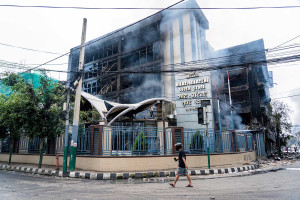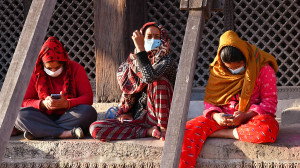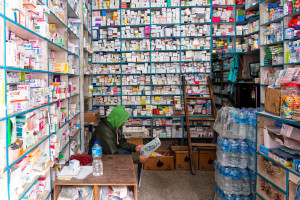Money
Tihar tourism rush fills Chitwan and Pokhara, but briefly
Domestic tourists crowd key destinations during the festival, giving hoteliers short-term relief after weeks of cancellations and low arrivals.
Ramesh Kumar Paudel & Anup Poudel
Tourism, which had slowed in September due to the anti-corruption Gen Z movement, suffered another setback during Dashain as heavy rains and landslides blocked highways across the country. But the situation was different during Tihar last week.
Sauraha, home to Chitwan National Park, drew so many people that moving around became difficult. However, the number of visitors began to drop as soon as the festival ended. This is why tourism entrepreneurs are not overly optimistic.
Asmita Mahato of Sauraha, a nature guide in the park, was extremely busy on Friday and Saturday. On Saturday alone, she took tourists on jeep safaris three times through the community forest and inside the park. Usually, she would go only once or twice a day. “Until Sunday, the number of tourists was okay, but I’m not sure what will happen from tomorrow [Monday],” she said.
Chitwan National Park is the top destination for tourists who want to see rare wildlife such as tigers and one-horned rhinos. Visitors enter the park through ten gates in Chitwan and Nawalparasi (Bardaghat Susta East).
According to data from the Sauraha ticket counter, there were very few tourists on the day of Bhai Tika (Thursday). But the next day, the number crossed a thousand. While thousands of Nepalis came through Sauraha, visitors from SAARC countries were very few.
The number of other foreign tourists barely reached 400. The lack of foreign visitors and the short-lived surge of domestic tourists have left local businesses less enthusiastic.
Shankar Yogi, an employee at the park’s Sauraha ticket counter, said that on October 17, a total of 1,388 Nepali tourists visited the park. The number steadily declined to 211 on October 23, before suddenly jumping to 1,465 the next day. On Saturday, it peaked at 2,563 domestic visitors.
That same day, 399 foreign tourists entered Chitwan National Park through Sauraha—the highest number recorded during Tihar.
“The number of Nepali visitors was really good on Friday and Saturday, but it was just a brief spike. It has already started to fall since Sunday,” said Om Pandey, president of the Regional Hotel Association Sauraha, Chitwan. “About 80 percent of the rooms were occupied for two days. Now it’s declining.”
In previous years, hotels remained nearly full from September through mid-December. But this time, Pandey said many bookings were cancelled right after the Gen Z protests. He expects hotel occupancy to fall to around 50 percent in the coming weeks.
The stagnation in foreign tourist arrivals is worrying local business owners. However, the situation is slightly better in western Sauraha, where foreign tourists are more common.
Subash Gurung, operations manager of Barahi Jungle Lodge in Meghauli, said that since October 10, his resort has seen steady tourist activity. His lodge hosts mostly foreigners—around 90 percent of guests—and the occupancy rate currently stands at about 80 percent. He expects this trend to continue for another month.
Each year, about 300,000 tourists—both domestic and foreign—visit Chitwan National Park. However, the number of foreign tourists has not increased recently, and even domestic visitors seem to be declining.
Since the start of the Tihar holidays, Pokhara’s hotels and tourist destinations have been crowded with visitors, and the rush has yet to subside. Favourable weather and the festive mood boosted the number of tourists in the city from the day after Tihar. In addition to domestic travellers, Indian and other foreign tourists have also been busy exploring the city.
Tourist flow had sharply declined during Dashain due to the Gen Z movement, but this was not the case during Tihar. Many tourists even struggled to find accommodation in Pokhara.
Chandra Bahadur Thing from Hetauda said he was surprised to see the massive crowd of tourists over the past two days. “I usually plan my trips during peak season, but this time, the number of people was overwhelming,” he said.
Since the Covid pandemic, domestic travel during festivals like Dashain and Tihar has grown significantly among Nepalis. September, October, and November are also the peak months for foreign tourists, when many come to Pokhara for trekking and sightseeing.
Pokhara serves as the main transit point for travellers heading to destinations such as North Annapurna Base Camp, Poon Hill in Myagdi, South Annapurna Base Camp, Mardi, Kapuche, Kori, Khumai-Korcha, and Tilicho Lake in Manang. Many tourists spend a night in Pokhara before setting off for their trek, making the city busier.
In addition, many Nepalis visit Pokhara itself with family and friends. Nearby tourist villages such as Sikles, Lwang, Ghandruk, and Tangting were also crowded. Business owners in all major tourist destinations of Gandaki province had even asked visitors not to come without prior bookings.
Pokhara has around 1,200 hotels, with a total bed capacity of 40,000. Laxman Subedi, president of the Hotel Association Pokhara, said the heavy tourist flow during Tihar greatly relieved hoteliers. He said that until Tuesday, 90 percent of hotels were booked. “Right before the main tourist season, protests and bad weather kept people indoors,” he said.
According to him, hotel occupancy during Dashain used to reach around 80 percent in previous years, but this year it fell to only 35 percent.
Balaram Giri, president of the Fewa Boat Entrepreneurs Association, said that the kind of crowd usually seen during Dashain’s full moon was witnessed in Tihar instead. “For the last three days, boat operators at all eight ghats have had no time to rest,” he said. “Usually, the crowd peaks during the full moon, but this time the number of domestic tourists was so high that it was difficult to manage.”
He estimated that around 20,000 tourists took boat rides and visited Tal Barahi Temple over the Tihar holidays. “We have eight ghats, and the rush has been so intense that boatmen can barely keep up. After Dashain, the weather improved, and as Pokhara is a prime tourist spot, the pressure increased sharply,” he said.
Krishna Prasad Acharya, president of the Gandaki chapter of the Trekking Agencies’ Association of Nepal, said the growing trend of hiking and trekking among Nepalis has brought huge relief to the tourism sector in recent years. He believes the sentiment of “exploring our own country first,” better road connectivity, and discovering new destinations have all contributed to the travel culture.
“Young people are getting more interested in adventure tourism. Many prefer to travel within Nepal before going abroad. Even Nepalis living overseas often return home during this season to travel,” he said.




 16.12°C Kathmandu
16.12°C Kathmandu1.jpg)














%20(1).jpg&w=300&height=200)
